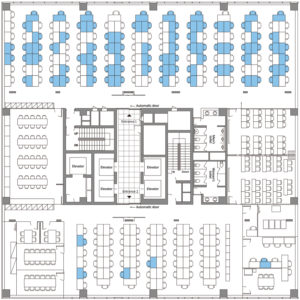Dave Moore, Staff Writer
It’s said that a picture is worth a thousand words.
On Thursday, May 29, the adage applied to a chart displayed by Carter Holston of NEC Corporation of America, which showed how a single office worker with COVID-19 infected a large percentage of his team in South Korea.
“That graphic from South Korea made me shudder,” said Michelle Vopni, Dallas Office Managing Partner of Ernst & Young, LLP, and 2020 Chair-Elect of the Dallas Regional Chamber.

When Holston displayed the chart earlier in the DRC’s Responsible Return to Work conference series discussion, he said: “There were 216 people on this floor, and it was a very open work environment. They’re shoulder-to-shoulder.”
The infections clustered on the same side of the building as the sick worker, he pointed out.
“One employee infected… 94 workers,” Holston said. “This really speaks to me (that) a lot of issue is with air flow” and other potential engineering-inspired changes to the workplace, he said. He noted NEC’s Irving facility is employing facial recognition and thermal scan technologies for individuals entering the property.
Holston, Vopni, and other professionals shared their best practices and tips during the virtual conference, which was presented by Furniture Marketing Group (FMG). During the call, FMG President Greg Almond displayed examples of physical barriers companies are installing to improve office worker safety.
Dr. James Cutrell, Program Director for UT Southwestern Medical School’s Infectious Diseases Fellowship Program, also discussed strategies and practices at work at UT Southwestern.
“The basics are still… where possible, where people can work from home and be productive and efficient, that’s still a great option,” Cutrell said.
Cutrell added that those employees who must return to the workplace should:
-
-
- Screen for symptoms before heading into work each day, and should stay home if sick;
- Maintain safe social distancing;
- Wear personal protective equipment (PPE); and
- Wash hands and disinfect surfaces frequently.
-
Cutrell, who also presented slides, said that employers can count on a year of “disruption as usual” in work, due to the novel coronavirus.
“This is a marathon, not a sprint,” he said. “Six months from now, no one is going to say, ‘I really missed that 50-person (in-person) meeting.’”
Some meeting participants said they’re encouraging workers to contribute their ideas and thoughts about employee safety via specific company email addresses.
Almond added that it’s relatively inexpensive for offices to add basic installations that improve worker safety.
Holston said it will be easier to increase office cleanings and to reconfigure spaces, compared to changing the behavior of individuals.
“I have pretty good confidence in (the effectiveness) of cleaning,” Holston said. “It’s modifying behavior that’s hard.”
Additional resources:
Watch more videos from our Responsible Return to the Workplace series on our YouTube channel.